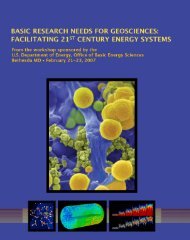Cyber Physical Systems â Situation Analysis - Energetics Meetings ...
Cyber Physical Systems â Situation Analysis - Energetics Meetings ...
Cyber Physical Systems â Situation Analysis - Energetics Meetings ...
- No tags were found...
You also want an ePaper? Increase the reach of your titles
YUMPU automatically turns print PDFs into web optimized ePapers that Google loves.
<strong>Cyber</strong> <strong>Physical</strong> <strong>Systems</strong> – <strong>Situation</strong> <strong>Analysis</strong>DRAFT – March 9, 2012The U.S. electric power system is currently 99.99% reliable, yet it is still susceptible to interruptions anddisturbances that amount to high costs. 102 These interruptions can be caused by unintentional incidents,such as excessive peak loads or natural accidents, or by intentional incidents, such as targeted cyberattack. Disturbances can cause destruction of critical process components and failures that stop generationand distribution of electricity to consumers in localized or widespread areas. 103 While some of thesesystem failures are localized to small regions, others can cause cascading power failures in larger regions,such as in the widespread power outage in the northeast United States and Canada in 2003. 104 While anincreased networking of the control of utility systems has many benefits, it also exposes the systems topossible attacks.In order for the water system to become more flexible and reliable, systems that allow for more secureautomation and provide real-time operational information are needed. CPS architectures that are able toadapt to a changing environment while remaining secure can help to improve the sector‘s resilience. Thewater systems will use the CPS technologies to quickly regain operation after an interruption, allow forself-repair and configuration, and real-time monitoring. 105While a majority of electricity is currently generated from coal, natural gas, and nuclear power, electricityproduced from renewable resources is estimated to increase to 16% in 2035. 106 Although renewablesources provide ―clean‖ sources of electricity generation, they sometimes provide intermittent or variablesources of energy. 107 CPS technologies and engineering will provide the next-generation controlarchitectures and platforms needed to optimize the electricity system as it is called on to integrate avariety of energy sources, including intermittent renewablesCPS technologies can also be used to help manage user consumption. For example, applying CPS to theadvanced metering infrastructure may enable more effective management of consumption by providingthe ability to schedule power utilization based on information from the meters. 108 Smart meters provideinformation for the development of technologies that can enable demand management, distributionautomation, substation intelligence, distributed generation, and information technology. The objective ofthese technologies is to increase energy efficiency through optimization, control, and a reduced peakload. 109 CPS technology will provide the tools for real-time, resilient, safe, and secure control of energysystems, resulting in highly integrated, dependable, and flexible energy technologies.The American Recovery and Reinvestment Act of 2009 (Recovery Act) provides funding of $4.5 billionto increase the rate of modernization of the electric grid, specifically through the Smart Grid InvestmentGrant and Smart Grid Demonstration programs. 110 There has been increased use and installation of smartmeters and advanced metering infrastructure (AMI), which is helping modernize the U.S. electric grid byreducing peak and overall electricity use. 111 In June of 2011, funding from the Recovery Act had alreadyfacilitated the installation of five million smart meters. These smart meters provide information about102 National Academy of Engineering. ―Greatest Engineering Achievements of the 20th Century.‖ 2012.http://www.greatachievements.org/?id=2998103 NITRD. Winning the Future with Science and Technology for 21 st Century Smart <strong>Systems</strong>. 2011.104 NITRD. Winning the Future with Science and Technology for 21 st Century Smart <strong>Systems</strong>. 2011.105 Adam, Nabil. DHS. Workshop on Future Directions in <strong>Cyber</strong>-<strong>Physical</strong> <strong>Systems</strong> Security. 2010.106 U.S. Energy Information Administration (EIA). Annual Energy Outlook 2012 Early Release Overview. 2012.107 NITRD. Winning the Future with Science and Technology for 21 st Century Smart <strong>Systems</strong>. 2011.108 NITRD. Winning the Future with Science and Technology for 21 st Century Smart <strong>Systems</strong>. 2011.109 Baheti, Radhakisan and Helen Gill. <strong>Cyber</strong>-physical <strong>Systems</strong>. 2011.110 U.S. Department of Energy (DOE). Smartgrid.gov. ―Overview of Programs, Studies and Activities.‖111 NITRD. Winning the Future with Science and Technology for 21 st Century Smart <strong>Systems</strong>. 2011.20
















